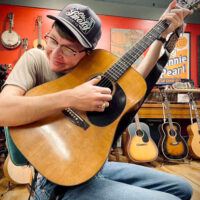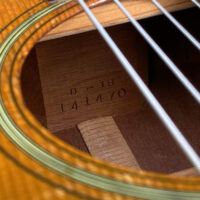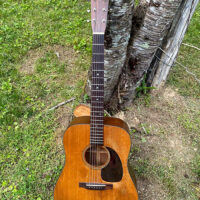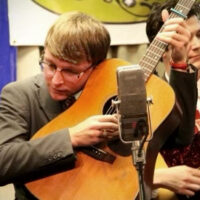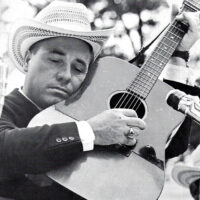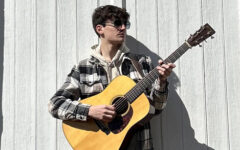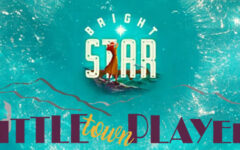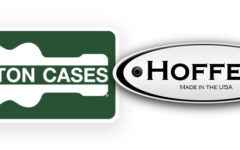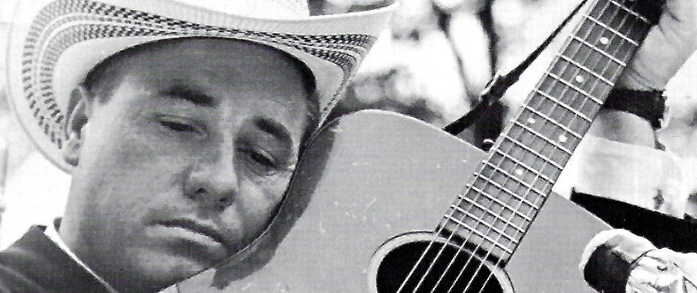
Earl Scruggs with his1955 Martin D-18 (Clemson University, 1964) – photo courtesy of Collectiques
Lincoln Hensley, banjoist with Tennessee Bluegrass Band, is a young man with an old soul. To be so few in years, he has amassed extensive knowledge of the history of bluegrass music, and the instruments played by its masters. Recently, we spoke with Lincoln about his passion for Earl Scruggs’ coveted 1955 Martin D-18, and the lengths he has gone to replicate that sound.
“When I first started playing banjo, a good friend gave me Flatt & Scruggs’ Martha White TV Show 10 disc set. I just about wore them out if you can do that with a DVD!”
Primarily a banjoist, Hensley was enthralled as well with the finger-picking style of the flat top guitar.
“I’d hear Earl and then Merle Travis. He’s another one of my big heroes. He plays that thumb style. Earl’s playing was kind a hybrid of Merle’s playing and banjo rolls. I called Edison (Wallin). I was about 14 years old and said, ‘I want to learn to play guitar like Merle Travis.’ He asked me what I wanted to learn and I said, Cannon Ball Rag. He showed me that tune over a landline phone that night.”
83-year-old Wallin recalled, “He asked me to teach him to play the guitar. I play Merle Travis style. I said it’s like patting your head and rubbing your belly. You play the melody with your forefinger and the timing (rhythm) with your thumb. Lincoln wanted to learn Cannon Ball Rag. He learned it over the phone in 30 minutes.”
Lincoln was consumed with a desire to master finger-picking on the six string.
“I sat forever on that thumb, playing the bass and the offbeat like a mandolin would, then you got to play the melody with your fingers. I sat in my room for about a month just working on the thumb part ’till I finally didn’t have to think about it anymore, so I could play the melody (with my fingers). I tried to take off and learn from everybody I met.”
After mastering the finger-picking style on the guitar, Hensley focused on the instrument that he had seen Scruggs playing in the DVDs. North Carolina musician and collector Larry Perkins had worked on Scruggs’ original guitar, and had it for several years after a trade with Earl.
“I’ve long ago lost count of how many times I’ve been asked about that guitar. Quite a few people saw me with that guitar when it was in my possession. Earl actually traded it to me for a D-18 very similar to it.”
First time I played it (in the late ’70s) I could hardly believe my ears, that Earl Scruggs – who could have had just about any guitar he wanted – chose that guitar and pursued Don Gibson over it and kept it all those years.
I know about his guitar, literally inside and out. During a visit with the Scruggs, Earl noticed that I had a car load of instruments, and wanted to see the Martins I had. We got them all out. There were a couple of old Herringbones, some ’30s era D-18s, a couple of ’50s and ’60s D-28s, a D-21 I think, and a ’52 or ’53 D-18 in the bunch. After playing on all the guitars for a bit, he kept going back to that early ’50s D-18 and finally wanted to know how much I would sell it to him for. He needed one because his old D-18 was in bad, unplayable shape. He was getting ready to start work on an album with Tom T. Hall and needed a good D-18. I suggested he get his guitar out and let’s have a look at it, that maybe it was something we could adjust and improve.
This was one of those giddy moments. I recognized it immediately. It’s the guitar seen in most of Flatt & Scruggs’ DVDs with the over-sized pickguard and a Gibson style truss rod cover on the peghead. Don Gibson bought the guitar new and had Shot Jackson trim the neck down to the point (where) Shot felt he better put a truss rod in it.
Earl played the guitar at the Opry one night and really liked it. Earl was in need of a guitar at the time, as the guitar he had been playing got destroyed in an accident (they backed the car over it). So Don sold him the D-18. This became Earl’s main guitar for years, until near the end of the Flatt & Scruggs partnership. He kept making attempts to have it repaired, without much success.
It was the worst, weakest sounding Martin I’d ever heard or played. It was heavy and it had rattles even when you’d clasp the strings down. A few years later I found out why.
It had the biggest bridge plate ever, and several extra pieces of bracing stock glued in beside the original braces. The dovetail was really loose and the Gibson truss rod that Shot Jackson installed for Don when he had the neck trimmed down ‘to play like a Fender’ was loose, and caused that terrible rattle. The top was bowed out nearly like the back on an Ovation. The pickguards that used to be on it were the ‘peel and stick’ kind, so when they started coming off, they didn’t leave a mark.
I was astonished at the shape his guitar was in that day (Earl wanted to trade): the neck was bowed nearly like a chair’s rocker. The bridge, which had been pinned, was pulled up so much that I could see the threads on the screws. The top was pulled up such that it looked more like an arch top than a flat top. Obviously, there was no adjusting I could do to help it at all.
I was surprised when he asked how much boot I would need to trade guitars with him. I told him that his guitar was worth a lot more than mine even in the shape it was in, so if anybody was going to pay any boot it ought to be me. We wound up trading even. Found out later that he was working on an album with Tom. T Hall, which turned out to be The Storyteller and the Banjoman. He played guitar on a couple songs and that’s why he was in need of a good guitar.
I took Earl’s old D-18 to my old friend, (the late) Harold Chriscoe, soon as I landed in North Carolina, knowing if anybody could fix it, it would be Harold. We had to totally disassemble the guitar. Removed the fret board and truss rod, put the neck in a jig Harold had made and began slowly steaming the outward bow out of it, then pulling the neck on back to put some bow in it in the opposite direction. It took several months, and then he put a new truss rod in and glued a new ebony fret board on it.”
Chriscoe’s oldest child, Garrett, recalled seeing the classic guitar in his dad’s shop in Seagrove, NC. “Dad steamed it over water, but he was careful not to harm the finish. It stayed in his shop a good while and he wouldn’t let anybody touch it ’cause it belonged to Earl.”
Perkins described all the repairs that it required.
“The top required similar treatment. It had to come off, and all the braces and tone bars (a couple were cracked anyway), and the bridge plate had to come out. My Dad, a pattern maker, made a jig which we used to slowly push the outward bow out of it, steamed it on in just a bit, then glued a new X-brace, tone bars, and bridge plate in, so that with the string tension on the top would be nearly flat. About six months later, the guitar was reassembled, and it played and sounded great – a most pleasant surprise. I finally heard what made Earl flip over it so when it was new. It sounded like a great above-average old D-18 and plays like a Strat.
Just a few days after I got the guitar back, Earl called and asked if I still had his D-18…of course I did. I told him I wouldn’t take a million dollars for that guitar. He said, ‘well I sure do hate to have to ask, but I need to get it back if at all possible. Me trading it off is causing a problem in my family.’
A ‘problem’ I brought on myself. A few weeks prior, during another visit with Louise and Earl, she was going through an old photo album and happened on an old picture of Earl with that guitar. My brilliant self said, ‘oh, that’s the guitar I’ve got.’
Of course we couldn’t have trouble in the family, so I took it back. Earl wound up with both guitars, but told me that he’d see to it that I got his D-18 back some day. (He was good as his word, but there were some changes made beyond his control that cancelled all that out).
The good thing is he wound up using my D-18 for his record with Tom T. and got years of trouble-free service out of his D-18. Harold’s work held up just fine and Earl played it right up to the end.
That it’s held together since the day I left Harold’s with it is a testament to his ingenuity, craftsmanship, dedication, and love for Earl’s music. Would have been something to had YouTube back then and videoed Harold dismantling that guitar and documented everything he did to make a guitar out of it again.”
Recently, young Lincoln Hensley began to pursue Earl’s trademark Martin.
“The first time I saw Earl play that old Martin with the double pickguards on it, I started researching and trying to figure out what kind of guitar it was. It had such a sweet sound. Earl would capo up past the fifth fret to do all those tunes like Jimmy Brown, the Newsboy.
I never could figure out what the serial number was. I’d heard it was a ’54 or ’55. I wasn’t real sure, but knew he got it from Don Gibson sometime in the late ’50s. He bought it backstage at the Grand Ole Opry. Don had just got it back from Shot Jackson doing some work on it. Earl couldn’t live without it so he bought it.
Fast forward ten years. Earl’s guitar recently came for sale at Gruhn Guitars, and they want $100,000 for it. For that size of bluegrass history, that’s nothing. That guitar recorded some of the most iconic gospel and sacred type numbers that bluegrass music has to offer.
I got to go and play it. I was dying to figure out what the serial number was. While there I took a picture of that serial number.’
Endorsed by Recording King, Hensley tried to recreate Earl’s famous six-string. He received aid from a vintage instrument collector who he became friends with through Facebook in years past, and formally met at Banjothon.
That friend, Tom Isenhour of Salisbury, NC, explained, “I noticed Lincoln wanted one like Earl’s famous ’55 D-18. He got a new RD-318 style Recording King guitar and put the big dark brown pickguard on it, and a white truss rod cover on the headstock, just like Earl’s. I thought that was pretty cool, as I too have always wanted one that looked like Earl’s, but never thought to do that.”
Hensley bragged on his friend’s bluegrass collection.
“Tom’s got some really, really good photos of Earl he took in the ’60s. He’s got some great photos of him with that D-18 in its heyday.
When I got that Recording King, I told him that I was going to make a tribute guitar out of it. Tom started helping me. He started sending me a bunch of these photos that had never been seen that he took himself and never published. I used that and got the Recording King kind of where I wanted it.”
Isenhour was intrigued with Hensley’s guitar envy.
“We discussed the details about Earl’s guitar after Lincoln went to Gruhn’s Guitars in Nashville to actually see and play the Earl guitar. It had gone through extensive repairs by Larry Perkins and Harold Chriscoe some years back, and the Scruggs family was ready to sell it. The way the guitar looks today is nothing like I remember seeing Earl play it back in the 60s.
Lincoln got the serial number while he was there. I knew I had three 1955 D-18s in my collection, and I told him he could have his pick to get the real deal like Earl had from 1955. Lincoln asked for the serial numbers I had. He picked the one that happened to be three numbers away from Earl’s famous D-18, or from the same batch when made at the Martin factory.
Lincoln received sage advice from the vintage collector.
“Tom said, ‘If you’re going to do this you need a real ’55 D-18.’ I told him I just didn’t have the cash to purchase something like that right now. He said, ‘I’ve got three from 1955, and I’ll make you a deal you can’t refuse.’ He did! He made me a deal that I couldn’t pass up. He said that I could have any of the three of them if you’ll take it out and play it.
I asked the serial numbers. Earl’s number is 141467. The first one he sent was 141470 which is three numbers away from Earl’s guitar. I said, ‘I want that one right there.’ He hadn’t sent me pictures. He said, ‘You’ll want to come over and play all three of them first and pick which one.’ I said, ‘Tom, I don’t care if that one has two sound holes, that’s the one I want.’ He wanted to know if it was pretty close to Earl’s and I said it was close enough!”
Isenhour readily agreed. “It was like Earl was smiling down to Lincoln to pick that one.”
To be certain, Hensley sought the guitar’s historical details from a professional.
“I called Greig Hutton who’s just put out a book on Martin Guitars, and he’s got all the serial numbers from the factory. He can tell you when they were started and finished. Mine and Earl’s guitar were started on January 7, 1955. It was the first batch of D-18s to be started in ’55. There were about 20 or 25 in that batch. Mine was the second to the last in the batch. It was finished on April 6. They built the whole thing lacking one day being three months. It was $130 new in 1955.
Tom met me in Asheville at a guitar show. I was scared to death that he was going to back out on me. He opened the trunk of his car and there it sat. It was in the original B-style soft case from Martin, which I don’t know how it survived. I’d never seen anything so pretty in all my life. I was shaking. He got it out and hit a G chord. It rang for about a minute it seemed like. I said, ‘I want it’ and we traded.”
Isenhour interjected, “Within a week he had my ’55 D-18. It had that vintage look with just the right amount of original mileage scars, cracks, and scratches on it. It needed very little set up to get it up to pro standards. I’m happy to see this guitar in the hands of a young musician that can appreciate what Earl Scruggs felt when he made a 1955 Martin D-18 his guitar of choice.”
The first song Hensley played on his new old guitar was Jimmy Brown, the Newsboy, just like he’d seen and heard Earl do countless times on the DVDs.
“It’s a treasure. It’s been taken care of. It’s got the original pickguard and still has original bridge. Never had a neck reset, original tuners, no refinish.
I took it to John Arnold. I had him go through it. He did a little fret work on it and re-glued the pickguard. It was starting to come up a little bit. He’s got it to where it’s just a dream to play.
I figured out real quick why Earl sticks these guitars up to his ears. If you put that thing up to your ear, it’s the best sound you’ll ever hear come out of a guitar. I was lucky to get it.
I got a real good shot of Earl’s top. At Martin at the factory, they would stack wood book matched, right on top of each other. The wood is no doubt from the same tree slab. It is Sitka Spruce on top, mahogany back and sides, and mahogany neck. According to John Arnold, the waves in the top, little squigglies going left to right, only shows up in Sitka wood when it is perfectly quarter sawn. Especially in the sun, they really show up good. Earl’s is identical.”
Lincoln concluded…
“Since getting this guitar, I play guitar at home and hardly ever play the banjo at home anymore. I’m careful not to wear my hands out because I play the banjo so much with the Tennessee Bluegrass Band, down in Gatlingburg and Pigeon Forge, filling in, or studio work. I play guitar and can still be creative. It’s also easier on your back and shoulders.
As soon as I get up in the mornings, I pick it up and play a chord on it. It’s real responsive. It’s not the loudest guitar. Chainsaws are loud, but that doesn’t mean they’re pleasant to listen to. The thing about these old 18s, especially this batch, you get way up the neck and that’s where they’ve got the sweetest sound. This one’s got that sparkle on the high strings. I haven’t laid it down since I got it.”
